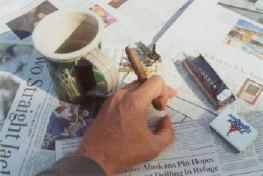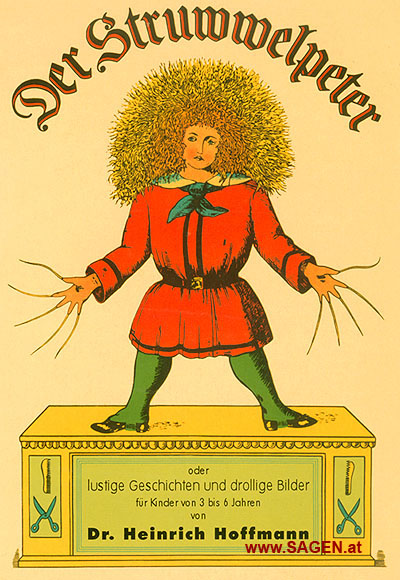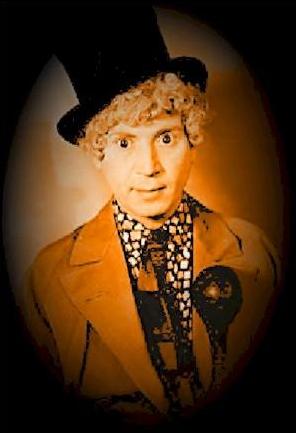|
RIPOSTE
by RIP RENSE |
 |
SIGGY STARDUST
(Oct. 5, 2009)
It’s hard to be glib about the Achim Freyer
L.A. Opera
production of “Siegfried,” which premiered Sept. 29. Just as it
is hard to be glib about, oh, murder.
I will say this, though,
with sadness and mixed emotions. It’s time for the great L.A.
Opera General Manager Placido Domingo, who has given so much to
opera in Los Angeles and the world, to think about moving on. He
has sold LAO out to Eurotrash silliness and
pseudo-intellectualism.
With this “Ring,” I thee
fled.
Here’s a little Ringside
blow-by-blow:
A walking gold top hat. A
walking green coffee cup (okay, stew-pot.) A walking pair of
green pliers. A walking green carrot---oh wait, must have been a
sword. A Siegfried who was half Lon Chaney Jr. under a full moon
(the bottom half,) and half some kind of
mutant Harpo Marx.
Check that---more like Shockheaded Peter.
StruwwelSiegfried. Erda, Brunhilde, and the Wood Bird
all with huge, painted-on breasts with gigantic nipples,
sometimes drooping and green, sometimes staring like giant red
eyeballs. . .
And yes, Wotan’s missing,
blinking orb looming once again above the stage (dropping at
one point in hamhanded symbolizing of his loss of power)---and
also
painted right on Brunhilde’s. . .crotch.
Gosh, do you suppose
this symbolized Wotan’s control over his daughter’s
chastity? Or maybe a touch of John & MacKenzie Phillips going on
here? Golly, such weighty implication! Oh, such Freudian
insight! One might never have thought of such things without
that big crotch-eyeball!
But. . .hmm. . .I dunno.
. .a Wood Bird with breasts? Now that’s one mixed-up DNA strand.
No, I don’t think even Wagner, with all his incest-heavy "Ring"
plotting and intra-species intercourse, would have quite
understood that particular amalgam. To be fair, though, Robin
Redbreasts might not have been Freyer’s doing, but that of his
costume designer daughter, Amanda, who likely subscribes to
sophomoric “feminist” notion of breasts symbolizing “power,” or
some such pop-think..
Sigh.
“Siegfried?” This was
Siggy Stardust. Ken Russell's Quadra-Ringia.
Did I say it was hard to
be glib about this? Check that. It's unpleasant to be glib about
Freyer's "Siegfried," but not hard.
Wait, there’s more!
RIPOSTE
EXTRA:
RENSE REBUTS L.A. TIMES MUSIC CRITIC MARK SWED'S REVIEW OF
"SIEGFRIED" HERE.
|
Little
raised platforms with inexplicable numerals on them. A sign
pointing
“Ost” (east.) A grotesque
Gerald Scarfe-esque circus
troupe parade (not seen since “Rheingold,” unless I had my eyes
closed and missed it during “Walkure”) featuring, quite
unaccountably, a mutant Dr. Seuss-ian dog and---here we go with
the areolas again---a comic book vision of Carol Doda and her
blinking 44’s. This appeared in Act 2, for no apparent reason.
Actually, that describes
Freyer’s whole approach to the Ring: no apparent reason.
Freyer apparently
believes that depicting his own obtuse symbolic rendering of
the operas, rather than the operas themselves, is the cat’s
pajamas (surprised a pair did not march across the stage.) This
sort of artsy-fartifice---“I’m doing a concept of Wagner’s
concept,” as he flatulently boasts--- is hardly unusual in
opera, though it constitutes the most widespread and successful
ploy in all contemporary art. That is, impenetrably
idiosyncratic statement passing itself off as interpretation.
The more outrageous and harder to parse, the better, as if
outrageousness and coy, guess-what-this-means device equate to
significance.
Booing really isn’t
enough for this $32 million nonsense (and there was a healthy amount of it
at the Siggy premiere---along with, I would estimate, hundreds
of empty seats---thank goodness.) I’d say it’s about time to
bring back rotten tomatoes. . .
Call me pedantic, but I
am of the opinion that interpretation, whether in poetry or
painting or operatic direction, should be somewhat intelligible.
That it should not require a key to decode the proceedings at
hand, or cryptic “explanation” by the director. This is not a
game---well, check that. They way the likes of Freyer and Robert
Wilson, another Wagner (and Puccini) assassin, play things, it
is exactly that: a game.
How would one know, for
glaring example, the meaning of Freyer’s scrim-projected moving
vertical lines without his explaining them? Well, turns out they
signify “mortality,” he reveals in program notes---or, as one
hilariously snooty audience member was heard to huff-and-puff to
his rapt companions at intermission (just before casually announcing
his impending business trip to Saudi Arabia) “Oh, those? They
mean death.”
And here I thought they
meant there was something wrong with the scrim projector.
Yawn. If Wagner wanted
vertical lines representing “mortality” in his operas, he
could have just had everyone wear stripes, and had the valkyries
ride zebras (whoops---hope I’m not giving Freyer any ideas.)
| That’s it, folks. Waiting for Hojotoho.
The whole opera is about. . .waiting. Really. This is Freyer’s
hypothesis. |
What
Achim the Awful has done here is really quite remarkable,
though, I’ll give him that. He has decided to mostly forego
characterization, plot, action, just about all of the intended
meaning and narrative of Wagner’s “Ring.” It is all beside the
Freyer point. He has instead decided that his idiosyncratic,
obscure, and all but impenetrable fever-dream hallucination of
these operas should supercede, well, everything.
Including the music and
singing.
Repeat: the music and
singing.
The poor wonderful music.
The poor wonderful conductor, James Conlon. The poor wonderful
orchestra. And most of all, the poor wonderful singers (whom
even L.A. Times critic Mark Swed admits are ballast in Freyerland.)
They have nothing to
illustrate. Nothing but a $32 million depiction of Freyer’s not
very interesting symbology, if you can call it that, littered
with his boorish obsession with “Star Wars”-style
light sabers
and other Hollywood/Eurotrashian devices. I mean, when all the parallel
neon lights on stage break slowly into fragments, as Siegfried
sings of the need to forge together the pieces of his sword,
Nothung, ah, we get it, Achim! If you were a high school kid, I
would give you such good marks. But you’re not, so I sat in
balcony A, my jaw agape at such an obvious trick, hearing the
late Merv Griffin in my head:
“Ooooooooooooooo.”

Freyer's Siegfried, o. . . |

. . .Struwwelpeter, o. . . |

. . .El Harpo! |
No, this stupendous music
was just not designed to illuminate the paltry musings of a
crackpot. It was designed to illustrate a titanic mythological
tale of guile, power, loyalty, fiendishness, fate, heroism,
folly, love, heartbreak, nihilism, cunning, beauty, ambition,
horror, irony, innocence, death. And more! To illustrate a sort
of ultimate parable of yin and yang, aspiration and doom,
integrity and guile, foible and fate. To complement, underscore,
punctuate, reveal a story whose legendary symbolic, psychological,
sociological complexities are built in, and have been the
subject of countless books and essays since the “Ring” were
first staged.
To focus on one or two
supposed thematic aspects of “Siegfried” is simply
reductive, yet this is exactly what Freyer has done. Here, for
the record, is the man’s analysis of the third of the four
“Ring” operas---a highly episodic, plot-heavy,
practically
Byzantine storyline involving oh, epic scale opportunism (Mime
raising Siegfried to steal the Ring back from Fafnir the
dragon), resignation to grim fate (Wotan’s acceptance of,
indeed, furthering of, the end of the gods), awakening of love
(Siegfried, Brunhilde), and even a good, old-fashioned
dragon-slaying:
“Dwarf-brother Mime
awaits Siegfried’s maturation. Grandson of Wotan, Siegfried
awaits the sword. God Wotan awaits Siegfried’s victory.
Dwarf-brother Alberich awaits Mime and Siegfried. No longer
divine, Brunhilde awaits Siegfried. The dragon waits.”
That’s it, folks.
Waiting for Hojotoho. The whole opera is about. . .waiting.
Really. This is Freyer’s hypothesis. It’s like saying that
Hamlet is about talking. Everybody, after all, does a lot of
that. Oh, okay, I’ve shortchanged Herr Direktor. He also says
that “Siegfried performs the great penetration. . .into the
heart of the dragon, into the loathed foster-father Mime, into
the circle of fire around Brunhilde through the destruction of
Wotan’s power-spear. . .
“And into the woman.”
Really. He writes this.
Into the woman! I guess I should be thankful that he
doesn’t come out and say, “penis” instead of “power spear,” and
have the sword depicted as a giant phallus (as Wagner’s
great-granddaughter, Katherina Wagner, who had her father and
Goethe prancing about with enormous erections in the Bayreuth’s
“Meistersinger,” certainly would have done.)
Such penetrating insight,
Achim.
| This was a teensy-weensy Sesame Street lizard
of a dragon, smiling, with a top hat, who boinged around the
stage like Jerry Lewis on crystal meth. |
Sacrificed to Freyer’s ego and id are nothing less than all
the delights and rewards of the “Ring’”s Machievellian character
interactions, also known as. . .the story. As New York Times
music critic Anthony Tommasini said, with admirable
understatement: “I terribly miss the human dimensions of the
characters in this sci-fi ‘Ring.’ After all, Wagner meant for us
to see ourselves in this story of a tormented, overreaching god
and his dysfunctional family.” While it is certain that
neither Mssrs. Domingo nor Freyer intended a desecration, this
is the net result of the L.A. “Ring.” It’s not an affront to
Wagner, it’s an affront to an audience paying a premium for
tickets in hard times.
I mean, for this, L.A. Opera
reduced its staff by 17%, cut the number of performances this
season from 64 to 48, postponed a badly-needed Pavilion
renovation and the premiere of Daniel Catan's "Il Postino?"
Yes, a symbolic or
impressionistic rendering of the Ring operas---any opera---is
perfectly grand, as long as there is some relationship, if not
rapport, between what is depicted and the music at hand. Isn’t
that sort of Opera 101? But Freyer, in an apparent attempt to be
Dali, cast this consideration to the Magic Fire. As Wotan sings
his heart-rending farewell to his daughter, Brunhilde, in “Walkure”---one
of the most moving moments in all of opera---Freyer had Siggy,
in gold top-hat and shirtless blue musculature, strut right
across the stage. In “Siegfried,” as Brunhilde and Siegfried
engage in one of the most gorgeous love duets in all of opera,
one is left to try disregarding the fact that Siggy looks a lot
like
John Lithgow in “The Adventures of Buckaroo Bonzai” crossed
with Goldilocks. In all seriousness, had he taken out a Harpo
horn and honked it a couple of times, it would not have
surprised me.
The problem with
Dreyer trying to be Dali, of course, is that he is not Dali.
He lacks, among other things, Dali’s wit and illuminating
intellect. Speaking of illumination, this entire “Ring” takes
place in darkness. Perpetual
nacht. There are no
“places,” no settings, no locales---just the big spinning
World-Frisbee floating in an apparent ur-universe, on
which Freyer sets all the singers. Who move ever so
ever-so-slowly. While the Frisbee spins ever-so-slowly. And the
black-suited “invisible” stagehands carry the glowing green
carrots, etc., ever-so-slowly. Or step ever-so-slowly from left
to right, and right to left, to depict, oh, left and right and
right and left, I guess.
The whole ever-so-slow
production seems to take ever-so-forever. And let me assure you
that even when staged literally, milking all the action
available to a director and conducted at taut tempi, “Siegfried”
is a long five-hour haul. Such contrived conceit as Freyer’s
waiting and penetrating aims to buffalo the viewer
into thinking he or she is witnessing something fraught with
psychological revelation. Sing with me now: Forever Jung. . .
There were two dramatic
exceptions to the slowness (which, not incidentally, is a device
Freyer seems to have appropriated from Robert Wilson, whose
“Parsifal” and “Madame Butterfly” cast struck poses that would
make a chiropractor shudder, and almost never moved.) First was
the moment where Siggy and Mime did the Can-Can together.
Yes, you are reading
correctly.
Siegfried and his
dwarf-stepfather, Mime, danced the Can-Can. One can only assume
that this was because there was not enough room to fox-trot.
(Watch video
here.)
| From his rising foof of white artiste
hair to his lowbrow goof of interpretive ideas, Freyer is a laugh
and a half. |
Then
there was the dragon. Oh, my, and what a dragon it was! Never
mind music that suggests a Wurmus Giganticus in all its
slumbering, lumbering menace, and that the voice is the bass-est
of baritones (amplified with echo in the Freyer Fest.) No, the
Freyer Fafnir was every bit as menacing as Cecil the Seasick Sea
Serpent, playful as Wally Gator, idiotic as Barney. This was a
teensy-weensy Sesame Street lizard of a dragon, smiling, with
a top hat, who boinged around the stage like Jerry Lewis on
crystal meth.
I guess you get the
drift.
As I said, there was a
healthy chorus of boo’s for Freyer following “Siegfried,”
led by your faithful Ringside commentator, me, the
no-longer-so-Lonely Booer (see prior
article, and article.) Yes, it seems that the audience is catching on to
the fact that this Emperor is shivering naked, and this “Ring”
is a dreary carnival. With all the empty seats in the house, one
must now wonder how L.A. Opera will ever manage to sell out its
three “Ring” circuses to be performed in June, 2010. Perhaps it
will rely on critic Swed, who has gone from tempering his
endorsement (and even pronouncing Freyer’s approach “weird” at
one point) to, with “Walkure” and “Siegfried,” a
love-fest in
print.
Is there anything at all
to recommend this “Siegfried?” Yes. How ironic that the music is
superbly realized, and the singing is so excellent. At the
as-usual fabulous pre-opera “Siegfried” lecture, conductor James
Conlon announced that the scrim/screen had at last been removed
from atop the orchestra. (It was employed per Wagner’s direction
that the ensemble be invisible---and removed after unanimous
complaints by critics, as well as The Rip Post.) As a
result, the music was suddenly free to boom and roar and lilt
and whisper clearly, sensitively, filling the Pavilion. All
those years of prattle by Swed about how abysmal is the sound in
that fine hall just seemed absurd.
And if you closed your
eyes so you could not see John Treleaven humiliate himself in
the degrading Siegfried get-up (and being a good enough sport to
act the part, as per Freyer’s instructions, like a
tantrum-throwing baby alternating with Karloff’s Frankenstein)*,
you would have been thrilled at his heady, durable heldentenor.
Linda Watson’s rendering of Brunhilde was, absent one moment
where she seemed to lose her place (or swallowed wrong?), shaped
with panache, power, and sheen. Mime (Graham Clark) was
pleasingly fiendish and, appropriately, perversely likeable. Vitalij
Kowaljow continued his splendid Wotan (The Wanderer, in this
opera) no easy trick while
wearing a
birdcage on his head,
and the rest of the cast was crackerjack: Jill Grove as Erda,
Eric Halfverson as Fafnir (though needlessly amplified), Stacey
Tappan as the Wood Bird, and Oleg Bryjak as Alberich. The applause was duly
thunderous for orchestra, singers, supernumeraries, and duly
peppered with booing for the director.
In sum, Achim Freyer
might be a fun bridge partner, or he might be nice to his
dog, but as an opera director, he makes a very good Woody Allen
caricature. From his rising foof of white artiste hair to his
lowbrow goof of interpretive ideas,
Freyer is a laugh and a
half. Or he would be, if he were not being paid many millions of
dollars to indulge himself, and ignore Wagner, in staging “Der
Ring des Nibelungen” for L.A. Opera.
Small wonder, with all
that cash in the bank, he was seen smugly
chuckling to himself
throughout the performance.
Well, at least he
understood it.
* The tenor was injured while executing this ungainly
characterization on Freyer's dark, tilted, and, it would now
seem, perilous stage, in the Oct. 4 performance. He limped
through the end of the opera with an
ankle injury.
RENSE'S
RING COVERAGE. . .
Reviews and
commentaries of L.A. Opera's controversial staging of
Wagner's "Der Ring des Nibelungen."
Val-hell-a
(Feb. 25, 2009)
Rense reviews "Das Rheingold," the first in the series of
four operas.
The Lonely Booer
(Apr. 8, 2009)
Rense reviews "Die Walkure," the second in the "Ring" cycle.
Also, Rense reacts to L.A.Times music critic Mark Swed
noting the presence of a "lonely booer" letting loose at
the sight of director Achim Freyer. The "lonely booer"
was. . .Rense.
A
Boo For Swed (Apr. 8, 2009)
Rense comments in sidebar on Swed's assertion that
listening to Wagner might make you "want to keep company
with Hitler."
The Lonely Booer
2
(May 1, 2009)
L.A. Times music critic Mark Swed boos back at Rense, and
Rense responds.
Southland
Uber Alles (July 29, 2009)
Rense comments on L.A. County Supervisor Mike Antonovich's motion to
quash a citywide "Ring" Festival on the basis that
Wagner was an anti-Semite.
Siggy Stardust (Oct. 5, 2009)
Rense Reviews L.A. Opera's "Siegfried."
Rense Rebuts L.A. Times's Mark Swed on "Siegfried"
(Oct. 5, 2009)
Rense counters Swed's cheerleading for absurd Achim
Freyer production. |
BACK TO
PAGE ONE |
![]()